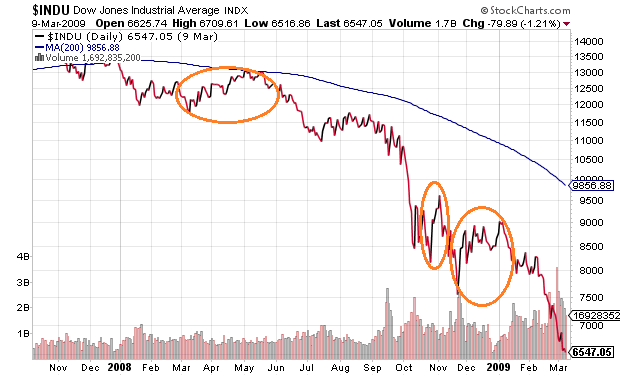Bull markets have corrections. Specifically, long-term uptrends often hit roadblocks where stock assets may pull back by 10%, 14%, even 19%. Those who may have been holding some cash typically benefit from buying into weakness at significantly lower prices.
Bear markets have bear market rallies. Selling pressure typically abates long enough to allow buyers to push stocks higher by 10%, 14%, even 19%. During long-term downtrends, however, attempts at “bargain purchases” can exacerbate portfolio losses and damage psychological resolve.
Consider what transpired in 2008. In the first half of the year between March and May, the Dow rallied 11% off its lows from 11,740 to 13,028. The ten weeks of “good vibes” had convinced many people that the worst was behind them. They were wrong.

Now look at the epic one-week period from October 27, 2008 through November 4, 2008. The Dow catapulted from 8175 to 9675 for a monster 18% rally. Surely the worst had to be in the rear-view mirror, right? Unfortunately, many buyers who bought in those early days of November later found themselves with assets worth roughly 70 cents on the dollar. (Again, attempts to eat directly out of a bear’s paw can exacerbate overall portfolio loss as well as kill one’s psychological commitment to market-based investing.)
Not surprisingly, there was a third head-fake. The Dow’s late November mark of 7550 jumped all the way back up to 9034 by the first trading day of 2009. That’s a 19.6% bear market rally that, ultimately, failed to inspire investor confidence.
“But Gary,” you protest. “The Dow and the S&P 500 are currently trading between 13%-14% off of there all-time highs. How do you know this isn’t just another stock market correction in a longer-term uptrend?”
I don’t know for sure. Nobody can. I may have made the case for the strong probability that the market had hit the top in the summertime. (Review August’s Market Top? 15 Warning Signs, or July’s 5 Reasons To Lower Your Allocation To Riskier Assets.) Nevertheless, there are no certainties when it comes to percentage moves for stocks, bonds, currencies or commodities.









Leave A Comment